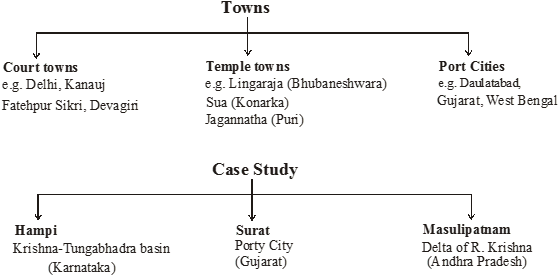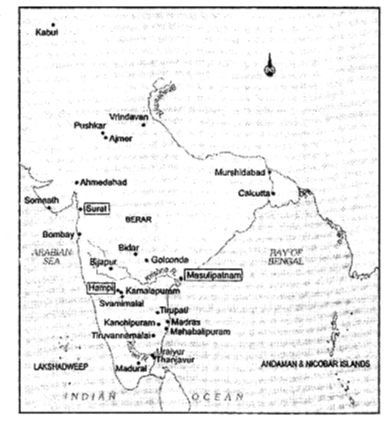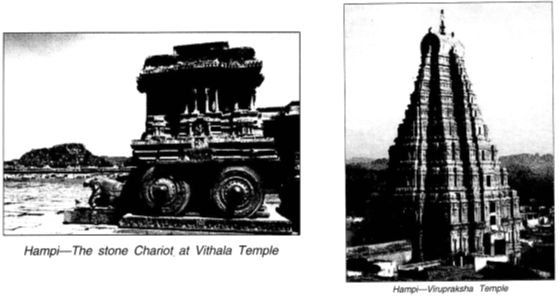- Books Name
- CBSE Class 7 Social Science Book
- Publication
- Param Publication
- Course
- CBSE Class 7
- Subject
- Social Science
Abstract of the Chapter

* Introduction
(i) Throughout history, cities, towns and urban areas have served as centres of culture and civilization, facilitating the evolution of knowledge, writing, fine arts, industry and commerce.
(ii) These urban centres play a primary role in the transformation and growth of the economy, in the division of labour, in social, cultural, political evolution, and in opening up to the modern world.
(iii) Towns and cities are the engines for sustainable development and can be part of the world economy.
(iv) In this chapter, we shall study a variety of urban centres such as court towns, pilgrimage centres, ports and trading towns that emerged and developed in the Medieval Period.
* COURT TOWNS OR CAPITAL TOWNS
The court towns are capital cities and the official seat of government in a political entity, such as a state, nation or kingdom.
During this period, a number of Medieval Indian cities emerged.
(i) They were Delhi, Ajmer, Kannauj, Dhera, Mahoba, Chillin, Tripuri under the Rajput Dynasties;
(ii) Kanchi, Badami and Ellora under the Pallava rulers of South India;
(iii) Lahore, Agra, Fatehpur Sikri under the Mughals.
(iv) While Udaipur was the capital of the Rajput kingdom of Mewar, ruled by Ranas of the Sisodia clan,
(v) Fatehpur Sikri served as the political capital of the Mughal Empire under Akbar’s reign from 1571 until 1585. when it was abandoned due to acute scarcity of water.
* PILGRIMAGE CENTRES
(i) In the Medieval times, many places emerged as the pilgrimage centres.
(ii) People believed that visiting these pilgrimage centres washed away all sins.
(iii) There were different pilgrimage centres for Hindus and Muslims.
(iv) The Hindus had four important religious sites - Kedarnath, Gangotri, Yamunotri, Rishikesh. These four places together comprise the Chardham. It is believed that travelling to these places leads to ‘moksha or release from the cycle of rebirths.
(v) Vrindavan is still an important pilgrimage centre for many Hindus.
(vi) Muslims went on Hajj.
(vii) This tradition still continues among this community throughout the world.
(viii) The Hajj is the pilgrimage to Mecca.
(ix) Every Muslim is obliged to undertake a Hajj at least once in his lifetime.
* PORTS AND PORT TOWNS
(i) A port is a place where ships load and unload their goods.
(ii) They are usually situated near the sea or ocean. In the Medieval Period, trade and commerce flourished well with the development of various seaports.
(iii) The beginning of foreign trade led to the development of market places not only in towns but also villages.
(iv) The production of handicrafts increased in order to keep up with the demand for them in foreign countries.
(v) The places with ports helped develop foreign trade.
(vi) The ports themselves grew into thriving towns and cities.
(vii) They became meeting points of foreigners and Indians.
(viii) On the western coast of India—Cambay, Sopara, Broach.
(ix) SURAT, DWARKA, COCHIN, GOA, KAWLAM had become very important seaports because of their trade practices with African, South-West Asian and European countries.
(x) On the East coast were the towns of Tamralipti and Vishakhapatnam through which India maintained commercial relations with South-Eastern countries.

* FLOURISHING OF SEA-TRADE PRACTICES
(i) India was famous for its textiles which formed one of the chief items of export. Duarte Barbosa, a Portuguese official in Cochin in the early 16th century, described Gujarat as a leading cotton trade centre.
(ii) Patola, which is a kind of silk dyed in natural colours, was highly popular in South-East Asia.
(iii) It was in great demand among the wealthy classes in Malaysia, Indonesia and Philippines.
(iv) Ibn Batuta mentions the production of silks in Bengal.
(v) Sirbund, a type of cloth used for tying turbans, was manufactured in Bengal.
(vi) It was highly popular in Europe.
(vii) In South India, Malabar, Golconda, Shaliat and Pulicat were also important textile centres.
(viii) Golconda was famous for Kalamkaris that were exported through the port city of Masulipatnam.
(ix) Other equally precious Indian items were hardwood furniture, carpets, ornamental work in cut stones, ivory, tortoise shells.
(x) Diamonds and pearls were exported from the Deccan.
(xi) Indian spices were also greatly appreciated by the Mughals as well as Europeans,
(xii) Indian arts and crafts were patronised by Indian rulers.
(xiii) India also imported goods from foreign countries.
(xiv) The chief articles that were imported were: horses from Kabul and Arabia, dry fruits and precious stones, glasswares from Europe, high grade textiles like satin from West Asia.
(xv) Raw silk and porcelain from China were also in great demand in Indian markets.
* FLOURISHING OF DOMESTIC TRADE
(i) We get a superb idea about the enormity of the domestic trade in Medieval India from the accounts of foreign travellers.
(ii) Ibn Batutah had described Delhi as a major trade centre.
(iii) The most superior quality rice and sugar found in Kannauj, wheat from Punjab and betel leaves from Dhar found their way to many parts of India due to excellent roadways.
(iv) During the two hundred years of Mughal rule, the urbanisation of India received a further impetus.
(v) The Mughal era witnessed the establishment of a stable centre and a uniform provincial government.
(vi) The prime urban centres during the Mughal era were Agra, Delhi, Lahore, Multan, Thatta and Srinagar in the North.
(vii) The important cities in the West included Ahmedabad, Bombay (then known as Khambat), Surat, Ujjain and Patan (in Gujarat).
(viii) The flourishing trade centres in the Eastern part of the country were Dacca, Hoogli, Patna, Chitgaon and MURSHIDABAD.
(ix) Hampi—the capital of Vijaynagar empire, Masulipatnam on the Bay of Bengal and Surat in Gujarat were the three flourishing trading towns during the medieval times.
* CASE STUDY—HAMPI
(i) Hampi, the 14th century capital city of the Vijaynagar empire, lies in the Deccan in the state of Karnataka.
(ii) Hampi is situated 74 kms from the city of Bellary and 13 kms from Hospet in Karnataka.
(iii) The ruins of Vijaynagar empire in and around the village of Hampi are spread over an area of more than 26 sq. kms.
(iv) This is one of the most fascinating historical sites in southern India.
(v) The area of Hampi is protected by the tempestuous river Tungabhadra in the north and by rocky granite stones on other three sides.
(vi) The monolithic sculptures and monuments along the temples are attractive because of their excellent workmanship.
(vii) The architecture found at Hampi reflects the Hindu culture and splendour of the Vijaynagar empire.
(viii) The rugged landscape adds to the historic ambience of this site.

(ix) Places of interest in Hampi are the Virupraksha Temple with its 50 metre high gopuram, Hemakunta Hill with ruins of Jain temples and a monolithic sculpture of Narasimha, Vithala Temple, Sule Bazaar, Achutaraya Temple, purandaradasa mandapa, royal centre that has the Lotus Mahal, the Queen’s Bath, etc.
(x) The Vithala Temple, the most splendid monument of Hampi, is situated on the southern bank of the Tungabhadra river.
(xi) It is known for its extensive sculptured work, ornate pillars and the carvings that decorate them.
(xii) This temple was built during the rule of King Devaraya II.
(xiii) The stone chariot in this temple is very famous.
(xiv) The stone wheels shaped in the form of a lotus are capable of revolving.
(xv) The Virupaksha or the Pampapathi temple is the main centre of pilgrimage at Hampi.
(xvi) This temple is in ruins but people still worship Lord Shiva here.
(xvii) It is situated in picturesque surroundings on the southern bank of the Tungabhadra River to the north of Hemkunta hill.
(xviii) The temple was renovated by Krishnadeva Raya in 1510.
(xix) The temple has several mandapas and murals.
(xx) The eastern gateway is a marvel of engineering skill.
(xxi) The hall has finely carved columns of animals and the ceiling is painted with scenes from mythology.
(xxii) The Karnataka government organises the Vijaynagar Festival in December every year where every effort is made to recreate the grandeur of an era bygone.
* CASE STUDY—MASULIPATNAM
(i) Masulipatnam , also known as Machilipatnam, is a city on the southeastern or Coromandel Coast of India situated on one of the mouths of the river Krishna on the Bay of Bengal.
(ii) Masulipatnam is the administrative centre of Krishna District in the state of Andhra Pradesh.
(iii) It was a 17th century port for French, British and Dutch trade.
(iv) The place derived its name from the construction of a gateway to the town decorated with eyes of fish.
(v) It was a flourishing sea-port during the Satvahana rule.
(vi) It was re-established in the 14th century by Arab traders who found their way from the Red Sea to Southern India.
(vii) Masulipatnam is also one of the earliest known British settlements in the subcontinent of India, its importance being due to the fact that it was the port of Golconda.
(viii) It was the British East Indian Company’s first trading post on the Coromandel Coast. An agency was established there in 1611.
(ix) This port-city is also famous for its Kalamkari textiles and printings created by using vegetable dyes.
(x) During the 17th century the western traders were attracted by this art which brought fabulous wealth to India.
(xi) The long, serene beaches of Masulipatnam attract many tourists every year.
(xii) During an annual Hindu festival— the Mahapoornima, thousands of pilgrims take a dip in the sea.
(xiii) The Pandurangaswami Temple dedicated to Lord Shiva is a great attraction for the Hindu community, while the Masulipatnam Church attracts the Christians.
(xiv) Vijayawada, which is 65 km from Masulipatnam, connects the city by road and rail with the rest of the country.
* CASE STUDY—SURAT
(i) Surat is a port city in the Indian state of Gujarat.
(ii) It is situated on the left bank of the Tapti River, 14 miles from its mouth.
(iii) Surat was the Mughal Empire’s most important port city, and is where the British gained their first foothold along the western coast of India.
(iv) The modern city of Surat was probably established in the 15th century.
(v) In 1514, the Portuguese traveller Duarte Barbosa acclaimed it as a major seaport.
(vi) The British are also believed to have entered India through Surat.
(vii) Surat eclipsed Cambay as the major port of Western India, as Cambay’s harbour had begun to silt up.
(viii) During the reigns of Mughal emperors Akbar, Jahangir and Shah Jahan, it became famous as a major trade centre of India.
(ix) Till the 16th century, the Portugese were the undoubted masters of the sea trade through Surat.
(x) But in 1612, the British destroyed Portugese naval supremacy and made the city the seat of a Presidency under the British East India Company.
(xi) Surat is now the heart of India’s thriving diamond-polishing industry. Furthermore, Surat is an industrial hub for the production of synthetic fibres and man-made fabrics.
(xii) So vital is the textile industry in Surat that the city has been called the ‘Manchester of the East’ since the British times.
* TRADERS IN MEDIEVAL TIMES
(i) Different communities dominated trade in various parts of the country.
(ii) Multani and Punjabi merchants handled the business in the North, while in Gujarat and Rajasthan it was in the hands of the Bhats.
(iii) Foreign traders from Central Asia, known as Khorasanis, engaged in this profession all over India.
(iv) Members of the nobility took an interest in trading activities.
(v) They set up their own manufacturing centres wherein local artisans were employed.
(vi) Internal trade flourished due to an organised system set up by the government.
(vii) The 14th century Sultan Alauddin Khilji, for instance, used to strictly supervise the market places.
(viii) Shopkeepers who were caught violating the rules, were severely punished. Sometimes the trading community used to face unfair treatment from government officials.
(ix) Sometimes they were forced by these officials to sell the products at reduced rates or on credit, thus incurring heavy losses in the process.
* INDIAN CRAFT AND CRAFTSMEN
(i) For centuries, Indian handicrafts have been distinguished for their great aesthetic and functional value.
(ii) Since Ancient Times, the craftsmen conceptualized intricate designs and patterns, which were crafted painfully into the temples and the objects associated with them.
(iii) Apart from the temples, other handicraft items too have gained immense popularity.
(iv) Handicraft items that were patronized by the Mughal royalty show a remarkable refinement of workmanship.
(v) These crafts were often influenced by Persian and indigenous painting traditions.
(vi) The artists prepared the designs on paper which were executed by the craftsmen.
(vii) The designs were assigned to different craftsmen according to their abilities and skill.
(viii) The master craftsman or designer visualized the complete design indicating the details of form, colour distribution and proportion to be realized by various specialists.
(ix) These designs were evident in Indian carpets, brocades, papier mache, stone inlay and so on.
(x) Wooden handicrafts, brass handicrafts, art work on stone, leather accessories, hand-made paper craft work, home furnishings and garment industries flourished greatly in Medieval times.
(xi) Both Indian craftsmen and traders had organised themselves into their own guilds which not only helped them in times of need but also helped them produce different articles of great quality.
(xii) Thus no country could match them in domestic and overseas trade.
* New Towns & Traders
(i) In the sixteenth and seventeenth centuries, European countries were searching for spices and textiles, which had become popular both in Europe and West Asia.
(ii) The English, Dutch and French formed East India Companies in order to expand their commercial activities in the east.
(iii) Initially great Indian traders like Mulla Abdul Ghaiur and Virji Vora who owned a large number of ships competed with them.
(iv) However, the European Companies used their naval power to gain control of the sea trade and forced Indian traders to work as their agents. Ultimately, the English emerged as the most successful commercial and political power in the subcontinent, taking them up.
(v) Indian textile designs became increasingly refined.
(vi) However, this period also saw the decline of the independence of craftspersons.
(vii) They now began to work on a system of advances which meant that they had to weave cloth which was already promised to European agents.
(viii) Weavers no longer had the liberty of selling their own cloth or weaving their own patterns.
(ix) They had to reproduce the designs supplied to them by the Company agents.
(x) The eighteenth century saw the rise of Bombay, Calcutta and Madras, which are nodal dues today.
(xi) Crafts and commerce underwent major changes as merchants and artisans (such as weavers) were moved into the Black Towns established by the European companies within these new cities.
(xii) The “blacks” or native traders and craftspersons were confined here while the “white” rulers occupied the superior residencies of Fort St. George in Madras or Fort St. William in Calcutta.
Illustration 1
Give an account of Industrial activities for which Surat is famous today.
Solution
Surat is known for its diamond industry. Known for its cloth industry, Surat is referred to as the Manchester of the East. Today, Surat is the industrial hub of many large industries like Reliance Petrochemicals, ONGC, etc.
Illustration 2
Explain the importance of Masulipatnam as a trading centre in the Medieval period.
Solution
The foundation of Masulipatnam was laid by the Arab traders in the 14th century. During the Satavahana rule, it was a flourishing sea port. In the 17th century, it was a centre of French, British and Dutch trade.
Illustration 3
Name the travellers who visited India and wrote about India’s thriving trade with the outside world.
Solution
Marco Polo and Ibn Batuta.

 Param Publication
Param Publication
